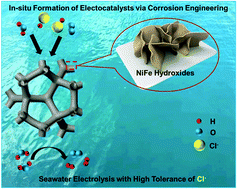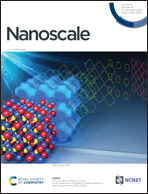Hydrochloric acid corrosion induced bifunctional free-standing NiFe hydroxide nanosheets towards high-performance alkaline seawater splitting†
Abstract
We report a facile route to fabricate free-standing NiFe hydroxides by corrosion engineering as high-performance bifunctional electrocatalysts for seawater splitting. Compared with H2SO4 and HNO3, HCl can promote the dissolution of Ni2+ from NiFe foam and the in situ formation of active NiFe hydroxides due to the strong interaction between Cl− and metal. In situ Raman spectroscopic characterization reveals that HCl corrosion induced NiFe hydroxides (HCl-c-NiFe) can generate oxygen evolution reaction (OER) active NiOOH species at a low potential of 1.4 V vs. reversible hydrogen electrode (RHE) and exhibits equally respectable activity for the hydrogen evolution reaction (HER). During a 1000 h test in an alkaline electrolyte or a 300 h test in an alkaline seawater electrolyte within a two-electrode system at 100 mA cm−2, the cell exhibits outstanding stability and high Cl− tolerance with a low working voltage of 1.62 V, outperforming benchmark Pt/IrO2 and most of the reported bifunctional catalysts.



 Please wait while we load your content...
Please wait while we load your content...